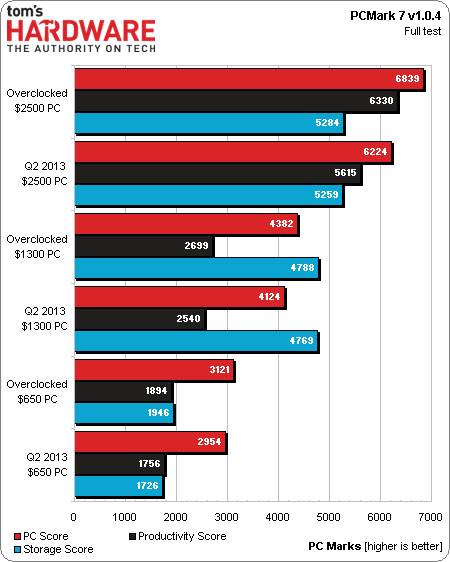System Builder Marathon, Q2 2013: System Value Compared
Results: 3DMark And PCMark
3DMark shows the expected performance-to-price scaling. It costs around twice as much to boost performance by about half.
Many of PCMark’s tests favor drive performance, giving the $1300 and $2500 PCs advantages that rarely occur in real-world use. With that said, we also know that the benefits of an SSD are often difficult to quantify, since they're largely response-driven. At least we have a mechanism here for crediting the solid-state-equipped systems with higher scores.
Again, PCMark’s storage tests do a good job of representing program startup times, in spite of the fact that most folks spend a small portion of their days waiting for apps to fire up. That’s why we use the most-pertinent access patterns we could think of to make up only 10% of each system’s performance profile.
Get Tom's Hardware's best news and in-depth reviews, straight to your inbox.
Current page: Results: 3DMark And PCMark
Prev Page Test Settings And Overclocked Configurations Next Page Results: SiSoftware Sandra-
manitoublack Great to see M-ITX in a SBM. The days of needing a full sized ATX are mostly over for 90% of people. M-ATO or M-ITX is the way forward.Reply -
DarkSable Sigh. This is why I really, really dislike the system builder marathons; they do nothing but perpetuate the fallacies that already are far too common.Reply
Someone looking at just this article, which isn't that unlikely, would be lead to believe that an i7 is something that an "ultimate" gaming computer has, that an expensive motherboard helps, and that a $2500 PC is going to be far better than a $1500 one. -
slomo4sho Reply11041161 said:Sigh. This is why I really, really dislike the system builder marathons; they do nothing but perpetuate the fallacies that already are far too common.
Someone looking at just this article, which isn't that unlikely, would be lead to believe that an i7 is something that an "ultimate" gaming computer has, that an expensive motherboard helps, and that a $2500 PC is going to be far better than a $1500 one.
They really should include performance per dollar figures in this writeup. -
DarkSable Reply11041186 said:They really should include performance per dollar figures in this writeup.
For the parts, or for the computers themselves? Either would be nice, actually.
One thing that would go a long way is stressing how wonky their testing is - most people reading this as advice for building a computer are going to be building a gaming computer purely, rendering 70% of the test bench pointless. -
slicedtoad I still don't like the bf3 benchmarks. They in no way represent the online experience and really, people that play bf3 spend at least 95% of their time on mp. I realize it's nearly impossible to generate a fair benchmark for online play but the current benchmarks are very misleading.Reply
And I'm not griping at tom's, all review sites seem to do this. There should be some way to create a better benchmark. Maybe host a custom server and load it up with scripted "players" or something. -
Achoo22 Reply11041210 said:most people reading this as advice for building a computer are going to be building a gaming computer purely, rendering 70% of the test bench pointless.
I feel like they've modified the benchmarking suite to favor AMD as much as possible. -
slomo4sho Reply11041382 said:I feel like they've modified the benchmarking suite to favor AMD as much as possible.
And when was the last time an AMD CPU made it into a SBM? Modifying benchmarks to favor a product that is never showcased is a moot point.




